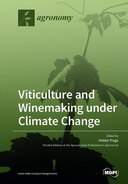Explore

Viticulture and Winemaking under Climate Change
Helder Fraga
2019
0 Ungluers have
Faved this Work
Login to Fave
The importance of viticulture and the winemaking socio-economic sector is acknowledged worldwide. The most renowned winemaking regions show very specific environmental characteristics, where climate usually plays a central role. Considering the strong influence of weather and climatic factors on grapevine yields and berry quality attributes, climate change may indeed significantly impact this crop. Recent trends already point to a pronounced increase in growing season mean temperatures, as well as changes in precipitation regimes, which have been influencing wine typicity across some of the most renowned winemaking regions worldwide. Moreover, several climate scenarios give evidence of enhanced stress conditions for grapevine growth until the end of the century. Although grapevines have high resilience, the clear evidence for significant climate change in the upcoming decades urges adaptation and mitigation measures to be taken by sector stakeholders. To provide hints on the abovementioned issues, we have edited a Special Issue entitled “Viticulture and Winemaking under Climate Change”. Contributions from different fields were considered, including crop and climate modeling, and potential adaptation measures against these threats. The current Special Issue allows for the expansion of scientific knowledge in these particular fields of research, as well as providing a path for future research.
This book is included in DOAB.
Why read this book? Have your say.
You must be logged in to comment.
Rights Information
Are you the author or publisher of this work? If so, you can claim it as yours by registering as an Unglue.it rights holder.Downloads
This work has been downloaded 279 times via unglue.it ebook links.
- 193 - pdf (CC BY-NC-ND) at Unglue.it.
Keywords
- adaptation
- adaptation measures
- assimilation
- autochthonous cultivar
- B. cinerea mold
- berry composition
- bioactive compounds
- Botrytis cinerea
- CIRG
- Climate
- Climate Change
- climatic influence
- Crop management
- crop model
- crop surface model
- crop water stress index
- Douro wine region
- drought
- dry mass partitioning
- elevated CO2
- EURO-CORDEX
- Face
- general circulation model
- Global warming
- grape
- grape berry tissues
- grape quality
- grapevine
- grapevine pest
- intercellular CO2
- Irrigation
- kaolin
- leaf area
- leaf water potential
- light micro-climates
- low-input
- mealybug
- mechanical thinning
- microclimate
- micrometeorology
- mitigation strategies
- modeling
- modelling
- multi-temporal analysis
- natural hail
- normalized difference vegetation index
- parasitoid
- phenolics
- phenological model
- phenology
- phenology modelling platform
- Photosynthesis
- photosynthetic pigments
- physiological processes
- plant architecture
- plant material
- Portugal
- precision viticulture
- predawn water potential
- PRI
- production system
- pulse amplitude modulated (PAM) fluorometry
- rate of anthocyanin accumulation
- RCP4.5
- Remote sensing
- rootstock
- S-ABA
- sensory analysis
- SO2 pads
- spatial variability
- stomatal conductance
- table grapes
- technological and phenolic ripeness
- temperature
- Touriga Franca
- Touriga Nacional
- Training system
- unmanned aerial vehicles
- vigour maps
- vineyards
- Virtual Riesling
- viticultural training system
- Viticulture
- Vitis vinifera
- Vitis vinifera (L.)
- Vitis vinifera L.
- water limitation
- water status
- WI
- wine
- winemaking
- yield formation
- ’Uva Rey’
Links
DOI: 10.3390/books978-3-03921-975-9Editions


